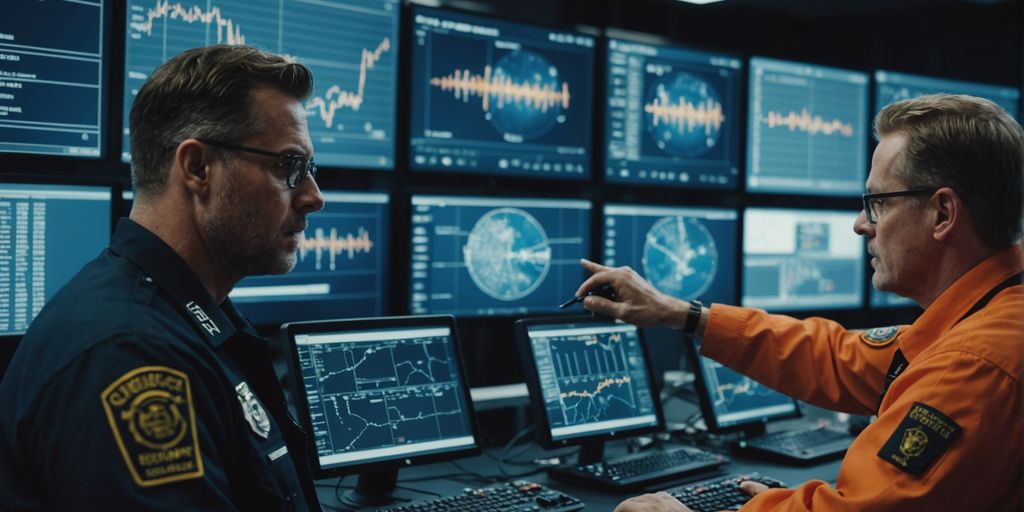In today’s unpredictable world, staying prepared for emergencies is more important than ever. Whether it’s natural disasters, health crises, or unexpected events, having the right knowledge can make all the difference. Here are some must-read articles that provide valuable insights into emergency preparedness.
Key Takeaways
- Finalizing Emergency Management Professionalization in 2024 covers the latest updates in the field.
- The Code of Ethics and Professional Standards of Conduct for Emergency Management Professionals outlines essential guidelines for ethical behavior.
- Factors that Support Public Health Infrastructure Recovery in Puerto Rico and US Virgin Islands after Hurricanes Irma and Maria discusses key elements for rebuilding.
- Forecasters, Emergency Managers, and Residents: Building Better Risk Communication focuses on improving communication strategies.
- Emergency Planning and Response provides practical tips for effective emergency management.
Finalizing Emergency Management Professionalization in 2024
The year 2024 marks a significant milestone in the journey towards finalizing the professionalization of emergency management. This effort has been a long time coming, with many dedicated professionals working tirelessly to establish a recognized and respected field. The importance of community and home preparedness is emphasized, ensuring that everyone is ready for any emergency situation.
One of the key aspects of this professionalization is the development of a comprehensive code of ethics and professional standards. These guidelines will help ensure that all emergency management professionals adhere to the highest standards of conduct, providing reliable and effective services to the public.
Another critical component is the focus on training, technology, and collaboration. By enhancing emergency response security through modern strategies, we can better prepare for and respond to various threats. This includes cross-training in emergency management, which ensures that all team members are well-versed in different aspects of the field.
As with everything in emergency management, effective execution is a work in progress. The proposal to finalize this professionalization represents good intentions and a commitment to continuous improvement.
In conclusion, the finalization of emergency management professionalization in 2024 is a crucial step towards creating a more prepared and resilient society. With the right strategies, tips, and essentials for emergency planning and response, we can ensure a safer future for all.
Code of Ethics and Professional Standards of Conduct for Emergency Management Professionals
The Code of Ethics and Professional Standards of Conduct is a guiding framework for all emergency management professionals. It ensures the delivery of effective, just, and compassionate services. This code addresses a range of issues that impact professionals in their day-to-day work, helping them maintain high standards of integrity and accountability.
Key Principles
- Integrity: Always act with honesty and uphold the trust placed in you by the public.
- Compassion: Show empathy and understanding in all interactions.
- Accountability: Take responsibility for your actions and decisions.
- Professionalism: Maintain a high level of competence and continue to develop your skills.
Importance of Adherence
Following this code is crucial for building trust within the community and ensuring that emergency management practices are both ethical and effective. It also helps in fostering a culture of continuous improvement and learning among professionals.
Adhering to these standards is not just about following rules; it’s about committing to a higher purpose of serving and protecting the community.
Implementation
To implement these standards, organizations can:
- Conduct regular training sessions on ethical practices.
- Establish a clear process for reporting and addressing ethical violations.
- Encourage open communication and feedback among team members.
By following these guidelines, emergency management professionals can better serve their communities and uphold the values of their profession.
Factors that Support Public Health Infrastructure Recovery in Puerto Rico and US Virgin Islands after Hurricanes Irma and Maria
The devastation caused by Hurricanes Irma and Maria in Puerto Rico and the US Virgin Islands was immense. Rebuilding the public health infrastructure in these regions required a multifaceted approach. Key factors that supported recovery included engaging community leaders, building infrastructure, enhancing preparedness, improving response capabilities, and leveraging technology for resilience.
Key Factors in Recovery
- Engaging Community Leaders: Community leaders played a crucial role in mobilizing resources and coordinating efforts at the local level. Their involvement ensured that the unique needs of each community were addressed effectively.
- Building Infrastructure: Reconstructing damaged facilities and upgrading existing ones were essential steps. This included hospitals, clinics, and other health-related infrastructure.
- Enhancing Preparedness: Preparing for future emergencies was a priority. This involved training healthcare workers, conducting drills, and ensuring that emergency plans were in place.
- Improving Response Capabilities: Strengthening the ability to respond quickly and efficiently to emergencies was vital. This included improving communication systems and ensuring that supplies and equipment were readily available.
- Leveraging Technology for Resilience: Utilizing technology to monitor and manage health services helped in building a more resilient public health infrastructure. This included telemedicine, electronic health records, and other digital tools.
The road to recovery for Puerto Rico and the US Virgin Islands after Hurricanes Irma and Maria was challenging, but the combined efforts of local leaders, healthcare professionals, and the community made it possible to rebuild stronger and more resilient public health systems.
Forecasters, Emergency Managers, and Residents: Building Better Risk Communication
Effective risk communication is crucial for ensuring the safety of communities during emergencies. Clear and timely communication between forecasters, emergency managers, and residents can save lives and reduce property damage. Dr. Tristan Wu’s research at UNT reveals how people react to different types of risk information, helping professionals develop better emergency plans.
Key Strategies for Better Communication
- Risk Assessment: Understanding the specific risks in an area helps tailor the communication strategy.
- Stakeholder Communication: Engaging with all relevant parties ensures that everyone is on the same page.
- Technology Utilization: Leveraging modern technology can enhance the speed and reach of communication.
- Real-Time Response: Providing updates in real-time keeps residents informed and prepared.
By harnessing human expertise and leveraging available resources, communities can work together to mitigate risks, enhance preparedness, and build more resilient systems.
Emergency managers and meteorologists can use these strategies to communicate more effectively with residents in risk areas. This approach not only improves safety but also builds trust within the community.
Emergency Planning and Response
Emergency planning and response are crucial for ensuring safety during crises. Effective strategies are needed to enhance response, mitigation, and recovery efforts. This involves preparing for disasters before they happen and having a solid plan in place.
Key Steps in Emergency Planning
- Create Your Emergency Plan: Discuss with your family or household members how to prepare and respond to the types of emergencies that are most likely to happen where you live, learn, work, and play.
- Identify Responsibilities: Assign roles to each member of your household and determine how you will work together as a team.
- Practice Your Plan: Practice as many elements of your plan as possible to ensure everyone knows what to do.
Meeting Points
- Choose two places to meet up:
- Right outside your home in case of a sudden emergency, such as a fire.
- Outside your neighborhood, in case you cannot return home or are asked to evacuate.
Planning and practicing your emergency response can make a significant difference in how well you handle a crisis.
Resources
- Consult our emergency resource library for tips on preparing for, responding to, and recovering from specific disasters.
- Use our free templates to document your plan:
- Family Disaster Plan Template – English
- Template Tips – English
Disaster Recovery and Business Continuity Planning
Disaster recovery and business continuity planning are essential for any organization to survive and thrive after a crisis. A business continuity and disaster recovery plan helps organizations and companies to prepare for potentially harmful and disruptive events. This plan includes strategies to minimize disruptions and ensure that critical operations continue without major hiccups.
Key Steps in Disaster Recovery
- Planning: Develop a comprehensive plan that outlines the steps to take before, during, and after a disaster.
- Doing: Implement the plan by training staff and conducting regular drills.
- Checking: Regularly review and update the plan to ensure it remains effective.
- Acting: Execute the plan during an actual disaster and make necessary adjustments based on real-time feedback.
Resources for Business Continuity
- Disaster Recovery Journal (DRJ): The largest resource for business continuity, disaster recovery, crisis communication, and risk management, reaching over 138,000 professionals.
- U.S. Small Business Administration: Offers business training and counseling to help you recover from any disaster and develop strategies for growth.
Taking advantage of business training and counseling can empower you with the knowledge you need to recover from any disaster and develop strategies for growth.
Importance of Regular Updates
A business continuity plan is not a one-time effort. It requires regular updates and reviews to adapt to new threats and changes in the organization. This ongoing process ensures that the plan remains relevant and effective in minimizing disruptions during a disaster.
Emergency Preparedness and Response Legislation
Understanding the laws and regulations that govern emergency preparedness and response is crucial for effective management. These laws provide the framework for how communities and organizations should prepare for and respond to emergencies.
One key piece of legislation is the Pandemic and All-Hazards Preparedness Act (PAHPA), enacted in 2006. This act authorized a suite of programs and authorities within the federal government to enhance public health and medical preparedness and response capabilities.
Another important regulation is the CMS Emergency Preparedness Requirements for Medicare and Medicaid participating providers and suppliers. This rule outlines the expectations for health centers to develop and maintain an emergency preparedness communication plan and to conduct annual training and testing programs.
Key Legislation and Regulations
- Pandemic and All-Hazards Preparedness Act (PAHPA): Enhances public health and medical preparedness.
- CMS Emergency Preparedness Requirements: Sets expectations for health centers.
- Community Planning Guides (CPG 101): Provides guidelines on developing emergency operations plans.
- Federal Emergency Planning and Response Authorities: Established by statute and executive orders.
Effective emergency preparedness and response legislation ensures that communities are better equipped to handle disasters and emergencies, ultimately saving lives and reducing damage.
Risk Management
Risk management is the process of identifying, evaluating, and prioritizing risks. This is followed by using resources in a smart way to minimize the impact of risks. It is important for both individuals and organizations to have a plan in place.
Key Components of Risk Management
- Identification of Risks: The first step is to find out what could go wrong. This includes looking at both internal and external factors.
- Evaluation of Risks: Once risks are identified, they need to be evaluated to understand their potential impact.
- Prioritization of Risks: Not all risks are equal. Some need more attention than others.
- Application of Resources: After prioritizing, resources are used to manage the most important risks.
Practical Applications
- Home Safety: Practical advice on home security and emergency preparedness can help protect your home and family.
- Business Protection: Businesses need to have plans in place to handle unexpected events.
- Public Health: Managing risks to human and ecosystem health is crucial for public safety.
Effective risk management involves collaboration between the private and public sectors to better manage risks to individuals, organizations, and society.
Emergency Management Today, Tomorrow, and in the Future
Emergency management is a field that is constantly evolving. Managing emergencies today while planning for tomorrow is crucial for ensuring communities are prepared for any situation. The new S&T landscape assessment report explores the current state of emergency management, identifies areas of opportunity, and drives proposals for future R&D.
Current State of Emergency Management
Today, emergency managers face a variety of challenges, from natural disasters to man-made crises. A well-documented emergency operations plan (EOP) ensures your organization is ready for various scenarios, from hurricanes to cyber-attacks. This is part of the three P’s of disaster preparedness: planning, practice, and performance.
Future Trends and Innovations
Looking ahead, the field of emergency management will continue to adapt to new threats and technologies. The continuous improvement program is essential for helping the emergency managers of tomorrow address these challenges. Working in emergency management is about being immersed in problems that need solving.
Building Better Risk Communication
Effective communication is key to managing emergencies. Podcasts like "Before, During & After" offer insights into where emergency management is headed and provide valuable conversations about preparing for future challenges. This helps in building better risk communication among forecasters, emergency managers, and residents.
While emergency managers around the world already have their hands full with disasters of increasing scope, severity, and frequency, megadisasters could overtake current preparedness efforts. It’s crucial to stay ahead of these potential threats.
Conclusion
Emergency management today requires a balance of addressing current issues while planning for future challenges. By staying informed and continuously improving, we can better prepare for whatever comes our way.
Severe Weather, Flood, and Hurricane Studies
Understanding severe weather, floods, and hurricanes is crucial for improving emergency preparedness. Texas A&M University researchers have collaborated to understand the impacts of storm surge floods before they occur to potentially reduce the level of damage. This proactive approach can save lives and property.
NOAA’s outlook for the 2024 Atlantic hurricane season predicts an 85% chance of an above-normal season. This forecast highlights the importance of being prepared for extreme weather events.
Extreme rainfall from an intensifying hurricane can result in widespread flooding and mudslides, causing damage to homes, businesses, and vehicles.
Key areas of study include:
- Observed changes in temperature, precipitation, storms, floods, and droughts.
- The impacts of hurricanes and global warming.
- Historical data on U.S. billion-dollar weather and climate disasters from 1980 to 2024.
These studies help us understand the patterns and effects of severe weather, aiding in better risk communication and emergency management.
Conclusion
Preparing for emergencies is something everyone should take seriously. The articles we’ve highlighted offer valuable insights and practical advice to help you and your loved ones stay safe. From creating a family emergency plan to understanding the latest in emergency management, these resources cover it all. Remember, the best time to prepare is now. Stay informed, stay ready, and stay safe.


